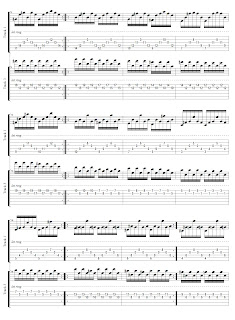The format is simple: I have four scales to introduce, each containing 7 diatonic modes - except the 8-Tone Spanish - who's bebop oriented architecture has 8 notes. The tabs will show the scales ascending the fretboard in 3 note per string patterns, which is favorable to memory and practice, although it's not the standard academic approach toward scale playing. It also offers a good challenge and stretch, something I think everyone should work on. In the final bar of each mode is the corresponding chord written in symbol form.
Neopolitan Minor: The Neopolitan minor differs from the natural minor in two places, it has a flattened 2nd degree and a raised 7th; you can also view it as a harmonic minor scale with only a flattened 2nd degree.
Neopolitan Minor: 1, b2, b3, 4, 5, b6, 7
Lydian #6: 1, 2, 3, #4, 5, #6, 7
Dominant Augmented: 1, 2, 3, 4, #5, 6, b7
Hungarian Gypsy: 1, 2, b3, #4, 5, b6, b6, b7
Locrian natural 3rd: 1, b2, 3, 4, b5, b6, b7
Ionian #2: 1, #2, 3, 4, 5, 6, 7
Altered bb3, bb7: 1, b2, bb3, b4, b5, b6, bb7

Neopolitan Major: This scale differs from the Ionian mode (natural major scale) by a flattened 2nd and 3rd degree. Visually, the first 3 notes resemble the Locrian scale, while the rest fits into place with our naturally occurring major scale. Its only distinction when compared against the melodic minor scale is the flattened 2nd.
Neopolitan Major: 1, b2, b3, 4, 5, 6, 7
Lydian Augmented #6: 1, 2, 3, #4, #5, #6, 7
Lydian Dominant Augmented: 1, 2, 3, #4, #5, 6, b7
Lydian Minor: 1, 2, 3, #4, 5, b6, b7
Major Locrian: 1, 2, 3, 4, b5, b6, b7
Altered natural 2nd: 1, 2, b3, b4, b5, b6, b7
Altered bb3: 1, b2, bb3, b4, b5, b6, b7
 Persian Scale: The Persian scale is very cool and offers a very distinct sound; it is heavy on chromatic (half-step) intervals. Its closest relative is the 3rd mode of the harmonic minor scale: the phrygian dominant. The Persian scale has a flattened 5th and a natural 7th by comparison. I have yet to find modal names for the scales.
Persian Scale: The Persian scale is very cool and offers a very distinct sound; it is heavy on chromatic (half-step) intervals. Its closest relative is the 3rd mode of the harmonic minor scale: the phrygian dominant. The Persian scale has a flattened 5th and a natural 7th by comparison. I have yet to find modal names for the scales.Persian scale: 1, b2, 3, 4, b5, b6, 7
Mode 2: 1, #2, 3, 4, 5, #6, 7
Mode 3: 1, b2, bb3, b4, 5, b6, bb7
Mode 4: 1, b2, b3, #4, 5, b6, 7
Mode 5: 1, 2, #3, #4, 5, #6, 7
Mode 6: 1, #2, 3, 4, #5, 6, b7
Mode 7: 1, b2, bb3, 4, b5, bb6, bb7

8-Tone Spanish Scale: The addition of an extra note causes a great deal of confusion. Some people may say this scale is the 7th degree of the minor bebop scale but I visualize it as a Locrian scale with an extra chromatic note. So we can double up on the third and have both the flattened 3rd and natural 3rd. Either way, this scale is very fun to play and in the examples I went to town playing the modes in thirds.
8-Tone Spanish Scale: 1, b2, b3, 3, 4, b5, b6, b7
Mode 2: 1, 2, b3, 3, 4, 5, 6, 7
Mode 3: 1, b2, 2, b3, 4, 5, 6, b7
Mode 4: 1, b2, 2, 3, #4, #5, 6, 7
Mode 5: 1, b2, b3, 4, 5, b6, b7, 7
Mode 6: 1, 2, 3, #4, 5, 6, b7, 7
Mode 7: 1, 2, 3, 4, 5, b6, 6, b7
Mode 8: 1, 2, b3, 4, b5, 5, b6, b7

http://www.youtube.com/watch?v=0eZHQu5oBjc
http://www.youtube.com/watch?v=ra4rDtiD3Yg
Happy woodshedding!








